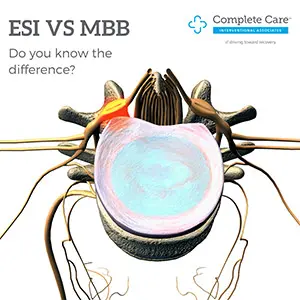 The Difference Between Epidural Steroid Injection and Medial Branch Block
The Difference Between Epidural Steroid Injection and Medial Branch BlockAuto injuries can cause many symptoms within the body depending on the mechanism of injury. Common symptoms include neck, mid back and lower back pain with or without radiating symptoms down the arms and legs. An initial exam is highly recommended after an auto accident to assess each part of the body and prevent permanent damage to the spine and nerves.
Early intervention treatments can prevent pain from becoming chronic, which could lead to more invasive surgeries and procedures being necessary in the future. At Complete Care Centers in Central Florida, our orthopedic specialists perform thorough examinations and state of the art diagnostic testing to get a clear picture of a patient’s injuries and how they can help reduce their symptoms in the least invasive ways possible.
If cervical, thoracic, or lumbar pain does not fully resolve after a patient goes through conservative care, there are many minimally invasive options that can provide long term pain relief. Two common procedures recommended by orthopedic specialists are epidural steroid injections (ESIs) and medical branch blocks (MBBs), also known as facet blocks.
Facet injections and epidural injections both reduce pain but target different areas. Epidural injections deliver steroid directly into the epidural space in the spain, while a facet block injects anesthetic around either the facet joint or medical branch nerve. The right treatment will be prescribed based on specific injuries and test results.
An epidural steroid injection delivers steroid medication directly into the epidural space in the spine.
Steroid medications are powerful anti-inflammatory agents, which help reduce inflammation around the spinal nerves which may be irritated due to a herniated or bulging disc. The saline mixed into the injection works by “flushing” or diluting the body’s automatic inflammatory fluids, also reducing pain.
A facet block or medial branch block involves injecting a small amount of local anesthetic (numbing agent) into the facet joint or surrounding the medial branch sensory nerve, depending on the specific approach. By placing the numbing agent specifically around either the facet joint or the medial branch nerve, the level of immediate pain relief experienced will confirm that the area injected is the source of pain. In other words, it is a diagnostic test. This procedure is not meant for long-term relief but can benefit some patients for longer than the expected 1-3 hours.
The presence of pain relief is an indicator that the next step of the procedure can be performed. The patient would then return to the office for Step 2, a Radiofrequency Neurotomy (RFN). This is the second step for long lasting pain relief. Radiofrequency neurotomy is a type of procedure used to treat joint/nerve pain. In this technique, radiofrequency energy is used to burn, or cauterize, the sensory nerve. This approach interrupts the sensory nerve’s pain signal to the brain; it does not affect the major spinal nerves responsible for strength and sensation. The RFN will often provide long-term pain relief lasting an average of 9 to 14 months, and sometimes even longer since the nerve may regenerate, and the pain may or may not return.
When a patient comes to Complete Care, they typically have already had diagnostic imaging performed such as X-Ray and MRI. These studies show the status of the intervertebral discs, the amount of space available for the nerves that come out of the spinal column, as well as the degree of inflammation that is in the area. A thorough health history and orthopedic examination reveal the severity of the pain, if radiating symptoms are present, and where the source of pain is coming from. From there, the doctor may order additional testing. Once all necessary information is gathered, our orthopedic specialist can formulate a diagnosis and plan of action. The decision between performing an ESI or MBB depends on a few key factors.
ESI’s are typically prescribed for patients with severe inflammation around the intervertebral disc caused by either a disc bulge or herniation. This inflammation puts pressure on the nerve, causing local and radiating symptoms such as pain, numbness or tingling in the arms or legs. The steroid can effectively reduce this inflammation, thus minimizing the pressure on the nerve and relieving the symptoms.
MBB’s on the other hand are indicated by facet (joint) pain that is commonly localized to a certain area of the spine. The medial branch of a nerve is the “pain producing” part of the nerve. By numbing this nerve, it is an effective way of determining that it is truly the source of pain before the RFN is performed. MBB’s do not involve the use of steroids but rather a numbing agent such as Lidocaine.
Modern technology has highly benefited thousands of patients by providing pain relief without the need for spinal surgery. At Complete Care, we are proud of our orthopedic team and their abilities to test, diagnose and treat patients suffering from auto injuries.
We provide not only interventional pain management, but also orthopedic spine and extremity surgery and neurology. For more information on how we can help, contact our team today. We provide convenient appointments at our locations across Central Florida, transportation, translation services and timely medical records and billing. Request an appointment or give us a call at (844) 699-2273.
The information provided on this website does not, and is not intended to, constitute legal advice; instead, all information, content, and materials available on this site are for general informational purposes only. Information on this website may not constitute the most up-to-date legal or other information. This website contains links to other third-party websites. Such links are only for the convenience of the reader, user or browser.